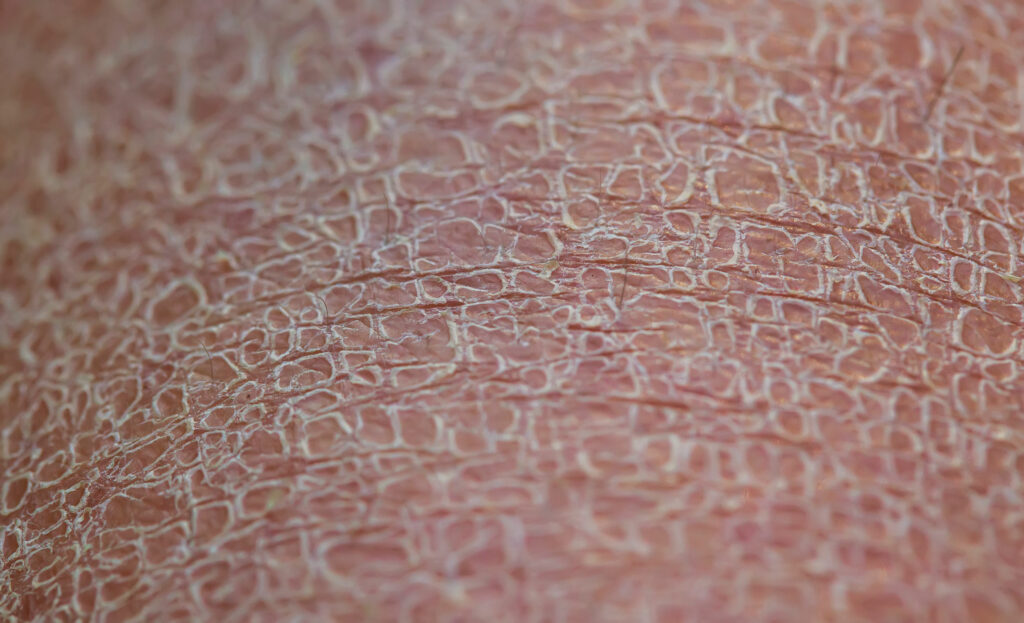Ichtyosis
Ichthyosis is a skin condition that causes thick, dry and rough skin with ‘fish-like scales’ which can be widespread and persistent.
What is it and how do I manage it?
Ichthyosis is a skin condition that causes thick, dry and rough skin with ‘fish-like scales’ which can be widespread and persistent. There are many different types of ichthyosis – some we inherit and start at birth, whilst others can develop as we go through life. While ichthyosis cannot be cured, it’s possible to manage your symptoms with a good daily skincare regimen.

Types of ichthyosis
There are at least 20 different types of ichthyosis, but we’ll cover the two most common.
Ichthyosis Vulgaris
This type of ichthyosis is inherited from your parents and is caused by a defect in a particular skin protein. Symptoms include fine, white-grey scales (this can be darker on dark skin). Uneven, 1cm- wide scales appear on the arms, legs, torso and scalp. The face, the bends of the elbows and knees are not normally affected.
Rough skin usually develops in babies by around two months of age.
Although ichthyosis vulgaris is a lifelong condition, symptoms get better as you get older and can also improve in warm, summer weather. Ichthyosis affects around 1 in 250 people, particularly Caucasians and those living in temperate climates. Up to half of people with ichthyosis vulgaris also have atopic eczema symptoms.
Acquired Ichthyosis
This more rare type of ichthyosis is not inherited but develops in adults, causing similar symptoms as ichthyosis vulgaris. It can be triggered by skin becoming drier as you get older and often develops when you have other medical problems or are taking certain medicines. If the underlying cause is removed, your symptoms can improve.
Acquired ichthyosis can affect you at any age if you have medical problems such as kidney disease, an underactive thyroid, HIV infection, sarcoidosis or Hodgkin’s lymphoma. It can also develop if you are taking certain medicines for conditions such as cancer, gout or indigestion.

General symptoms of ichthyosis
Symptoms of ichthyosis vulgaris and acquired ichthyosis are the same, but can look different from person to person. You may have a few of the following symptoms:
- Dryness
- Flaky skin
- Cracked skin
- Thickened skin
Ichthyosis triggers and factors
Some environmental factors can influence ichthyosis, including:
- Excessive washing
- Hot temperatures
- Air conditioning
- Cold, windy weather
- Swimming pool chlorine
- Health factors including excessive weight loss, vitamin A deficiency, age.
How to manage ichthyosis
Although there is no cure for ichthyosis, it’s a good idea to avoid environmental factors that can damage skin. Moisturising and exfoliating your skin each day can also help keep it healthy and prevent scaling. Here are a few more helpful tips:
- Apply emollients straight after bathing or showering
- Use a soap substitute as soaps can dry the skin out
- Bath rather than showering
- Use a wet pumice stone to gentle remove thickened skin
- Remove scalp scales by brushing wet hair
You can always get in touch with your healthcare professional for further advice on managing your ichthyosis.
Emollients
Emollients are moisturisers that can help with dryness. They are recommended for milder types of ichthyosis, such as ichthyosis vulgaris and acquired ichthyosis. You should apply emollients regularly, ideally one that is free from perfume and other additives that can cause allergies.
Washing with soap substitute emollients or bath oils rather than soaps can also help avoid skin irritation and dryness.
Emollients that contain urea, and/or lactic acid (see product’s label for these) can be useful in helping to remove scales. However, avoid using if the skin is particularly itchy or red because they may irritate the skin.
Exfoliants and keratolytics
Skin specialists may recommend you use emollients or peeling creams that contain ingredients known as keratolytics, such as urea, lactic acid or salicylic acid, which can help exfoliate and remove ichthyosis scales. These can be particularly useful for the palms of your hands skin and soles of your feet.
You should avoid keratolytics if your skin is red and itchy as they can cause irritation.
Prescription medicines
There are other treatments that your doctor, or specialist dermatologist can prescribe for ichthyosis. These can include retinoid tablets (synthetic vitamin A). Steroid creams or tablets are not recommended if you have ichthyosis. If your skin becomes infected, you may need an antibiotic or antiseptic to clear it up.
No products found